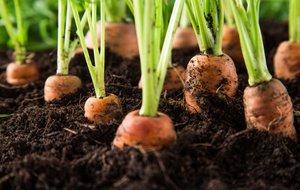Carrots. Sweet, tasty and packed with nutrients – it’s no wonder that they’re one of the nation’s most loved vegetables. While we can’t say for sure if they do help you see in the dark, we can all agree that carrots are an incredibly versatile vegetable. They’re a staple ingredient in various savoury favourites – as a popular side in a classic Sunday roast or finely grated in a summer salad, for example – yet just as tasty in sweet dishes, as the delicious carrot cake has proved time and time again.
But what do you need to know to growing your own supply of this tasty orange favourite?
Whether you’re just beginning your journey into gardening or a seasoned veteran, it’s no secret that growing carrots at home isn’t always an easy task. In this growing guide, we share with you the top tips and tricks for perfecting your homegrown goods, including advice on sowing carrot seeds, when to plant carrots and which are the best carrots to grow in the UK.
Common problems when growing carrots
Before we delve into exactly which carrots to grow and how best to plant them, it’s a good idea to be aware of one of the most commonly encountered problems when growing these delicious vegetables – so that you’ll be ready to prevent it. The biggest challenge that you may face is carrot flies. These pesky winged pests like to feast on plants and vegetables, wreaking havoc on your crop. The most reliable way that you can prevent this is by planting your carrots no earlier than June – but this is merely a month before the typical UK sowing season is over, so later than is ideal. It’s not all bad news, however, as there are other measures that you can take to stop these uninvited pests in their tracks.
The best option available to you is installing polythene cloches or investing in a polytunnel. These provide a physical barrier, creating a sturdy polythene film around your vegetable patch to prevent pests from reaching your crop. Our advice is to install your cloche or polytunnel as soon as possible, as this allows little-to-no time for any carrot flies to get trapped inside.
Best carrots to grow in the UK
 There are various types of carrots that you can choose to grow, including purple, yellow and white carrots, alongside the popular western, orange-coloured carrot that we are accustomed to seeing on supermarket shelves today. There isn’t necessarily a best type of carrot to grow; each simply has different tastes and textures. However, there are two categories into which different types of carrot fall: early varieties and maincrop.
There are various types of carrots that you can choose to grow, including purple, yellow and white carrots, alongside the popular western, orange-coloured carrot that we are accustomed to seeing on supermarket shelves today. There isn’t necessarily a best type of carrot to grow; each simply has different tastes and textures. However, there are two categories into which different types of carrot fall: early varieties and maincrop.
But what’s the difference between the two?
Early varieties are more suited to be sown between the winter/spring months of February-April; these carrots are much softer and more flavourful. Maincrop carrots are better suited to be sown between the spring/summer months of April-July. They are crunchier and can be stored for much longer than earlies, which is why some gardeners believe these to be the best carrots to grow in the UK – but it really is all down to personal preference.
When to plant carrots in the UK
When to plant your carrots is just as important as how you plant them. Timing is everything when it comes to growing your own vegetables. The main sowing season for carrots is April-July, months which usually provide the optimum outdoor growing conditions for carrots in the UK. Be sure to cross-check this on your seed packets, as some carrots can be grown in the earlier months of February-March if they are under cover in a polytunnel or polythene cloche to protect them from the winter frost and rainfall.
How to plant carrot seeds
When it comes to sowing carrot seeds, it’s isn’t as simple as just tossing your seeds into the soil at random and hoping for the best – your best bet is to be delicate and careful.
Firstly, using the edge of your trowel, make a small incision within the soil, around 1cm deep, carefully placing your carrot seed within it. The most important thing to remember when sowing carrot seeds is to leave around 5-8cm between each one that you plant. This is crucial as it gives your seedlings the room they need to grow to their full size beneath the soil. If you plant them too close together, your seedlings will end up competing for space as they begin to grow, which will result in under-developed carrots that are a little on the small side! Once you’ve finished planting each carrot seed, cover with soil and water with a rose-headed gardening can for best results. This will give the soil a light and even sprinkling of water.
When and how to harvest carrots in the UK
 When to harvest your carrots is subject to personal preference on the size and taste for which you’re aiming. Younger carrots tend to be softer and sweeter but also a lot smaller due to the shorter development time. Carrots that are harvested a little later in the season typically grow much larger – and crunchier.
When to harvest your carrots is subject to personal preference on the size and taste for which you’re aiming. Younger carrots tend to be softer and sweeter but also a lot smaller due to the shorter development time. Carrots that are harvested a little later in the season typically grow much larger – and crunchier.
Carrots are usually ready to be harvested 12-16 weeks after sowing – check your seed packets to find out when your chosen variety will be ready. Depending on the sowing times, the usual harvest time for early varieties is the beginning of June, while maincrop carrots can be harvested any time from mid-to-late June onwards. If you’ve grown maincrop carrots that you wish to keep throughout the winter, these ought to be harvested no later than mid-October for best results. Once harvested, store them in sand, in a dark place that is cool and dry.
How to care for your carrots
If you found the sowing process a bit fiddly, you’ll be glad to know that caring for your carrots as they grow is relatively straightforward. Carrots are resistant to drought, so they require very little attention when growing.
Be wary of weeds that can shoot up rapidly between your seedlings – regular maintenance to keep these at bay and avoid overcrowding is important.
You should also thin your carrot seedlings every few weeks, to give them plenty of room and optimum growing conditions, so that they aren’t competing with fellow seedlings for nutrients. Top tip: take care when thinning your seedlings – crushing the foliage releases an aroma that directly attracts carrot flies, so try to be as gentle as possible when handling them.
Garden accessories that will help you with growing carrots
Alongside the basic knowledge of how to plant and harvest your carrots, there are a few garden accessories that can help you to get the best results.
If you’re concerned about carrot flies, installing a polythene cloche tunnel is a fool-proof way of protecting your seedlings as they grow. This provides a physical barrier that prevents the carrot flies from accessing your homegrown goods.
Anti bird nets are also something to consider, if you want to protect your seedlings from threats up above as well as the ground. At Premier Polytunnels, our mesh netting has holes of 20cm – the optimum size to prevent small critters from getting in and feasting on your crop, while also preventing garden birds from becoming entangled within them.
If you’re opting to grow early varieties in February-April, you may wish to consider installing a garden shade net cloche. This will help to shield your crop from extreme winter weather conditions such as snow, rainfall and strong winds.
For optimum results, we recommend growing your carrots in a polytunnel. This will allow you to grow your seedlings in a fully controlled environment, where you can make the relevant adjustments to help your carrots reach their full potential.
Start growing carrots in a polytunnel today with Premier Polytunnels
For further advice on which polytunnel to choose or any other questions about our garden accessories, please don’t hesitate to contact our team on 01282 811250 or enquire via email at info@premierpolytunnels.co.uk.
With over 30 years of experience in horticulture, there’s nothing with which we can’t help you. Whether you need specific advice on a piece of equipment or you’d just like a couple of general polytunnel gardening tips, our friendly experts are always here to help.